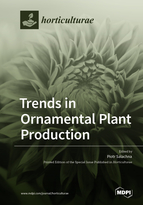Trends in Ornamental Plant Production
A special issue of Horticulturae (ISSN 2311-7524). This special issue belongs to the section "Floriculture, Nursery and Landscape, and Turf".
Deadline for manuscript submissions: closed (31 December 2021) | Viewed by 32389
Special Issue Editor
Interests: ornamentals; geophytes; propagation; method of cultivation; substrates; plant growth regulators; biostimulants; nanomaterials; stress mitigation; medicinal plants
Special Issue Information
Dear Colleagues,
The available range of ornamental plants (cut flowers, potted plants, bedding plants, perennials, bulbs, woody ornamental plants) is constantly supplemented with new species and cultivars, and thus new methods for their production are required. Sustainable development of floriculture requires modern and environmentally friendly solutions that would maximize the plant’s potential. An important role in modernizing ornamental crop production is played by substrates, fertilizers, plant growth regulators (PGRs) and biostimulants. Light, temperature and humidity are essential factors in maintaining plants. Research has been taking place in various science centers regarding the problems connected with the biology of ornamental growth and flowering, method of cultivation positively affecting plant quality, and working out modern cultivation technology.
Bearing in mind that modern ornamental plant cultivation needs practical, effective and, above all, environmentally safe solutions, we invite you to share your experiences in this area. Within the scope of this Special Issue, we highly welcome original research articles, full and mini-reviews, and communications of preliminary but significant results.
Dr. Piotr Salachna
Guest Editor
Manuscript Submission Information
Manuscripts should be submitted online at www.mdpi.com by registering and logging in to this website. Once you are registered, click here to go to the submission form. Manuscripts can be submitted until the deadline. All submissions that pass pre-check are peer-reviewed. Accepted papers will be published continuously in the journal (as soon as accepted) and will be listed together on the special issue website. Research articles, review articles as well as short communications are invited. For planned papers, a title and short abstract (about 100 words) can be sent to the Editorial Office for announcement on this website.
Submitted manuscripts should not have been published previously, nor be under consideration for publication elsewhere (except conference proceedings papers). All manuscripts are thoroughly refereed through a single-blind peer-review process. A guide for authors and other relevant information for submission of manuscripts is available on the Instructions for Authors page. Horticulturae is an international peer-reviewed open access monthly journal published by MDPI.
Please visit the Instructions for Authors page before submitting a manuscript. The Article Processing Charge (APC) for publication in this open access journal is 2200 CHF (Swiss Francs). Submitted papers should be well formatted and use good English. Authors may use MDPI's English editing service prior to publication or during author revisions.
Keywords
- Ornamental crops
- Floriculture
- Field and/or greenhouse cultivation
- Environmental factors
- Production technologies
- Plant propagation
- Biostimulants
- Floral marketing






